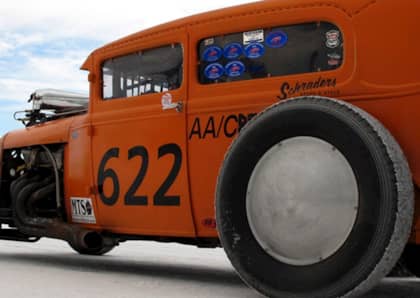10 Ways This 1,000 MPH Car Will Blow Your Mind
Yes, you read that right 1-0-0-0 miles per hour. The BLOODHOUND SSC (which stands for "supersonic car" of course) has been on a mission to surpass the current land speed barrier since the project was sparked back in 2007. They've come a long way, investing over 110 man years of effort into the project already - which is currently about 95% complete and being shown to the public at London's Canary Wharf over the weekend. It hasn't run 1,000 MPH yet - but is currently on schedule to make initial runs in 2016 with an aim at setting 1,000 in 2017. Watch the video for some mind-blowing facts and read on for our 10 Ways this supersonic car will blow your mind...
1. BLOODHOUND SSC is, without doubt, the most complicated car ever built. When finished, it will comprise over 3,500 parts (and 22,500 rivets), of which many have been designed and manufactured uniquely for this car.
2. When cars were a newly invented novelty it was believed that speeds as small as 50 MPH could kill a person. Eventually that was disproved and the race for 100 and then 200 mph were born. Any scientist will tell you that as you approach 200 MPH, the aerodynamics start really working against you and each additional MPH becomes exponentially more difficult. So you can imagine what that looks like by 1,000 MPH (it's an estimated 20 tons of drag on the car). The current land speed record stands at 763 MPH, which was also the first supersonic (breaking the sound barrier) land speed run - accomplished by the British Thrust SSC set in 1997 with Royal Air Force pilot Andy Green behind the wheel.
3. Powered by a jet engine and a rocket, with a Jaguar Supercharged V8 engine acting as a "pump", BLOODHOUND SSC will generate 135,000 bhp.
4. Mach 1 equals the speed of sound. 1,000 MPH is mach 1.4.
5. The first endeavor to successfully break the sound barrier was the Bell X-1 in 1946. Captain Chuck Yeager piloted the rocket type plane which was dropped out of a large B-29 and then accelerated from there. The speed of sound is 770 MPH but is affected by the air temperature. So during this attempt at 68 degrees, it was 767 MPH.\
6. At 1,000 MPH a mile will be covered in just 3.6 seconds. Want to put that into drag racing terms? Forget about a 9 second car, the BLOODHOUND SSC would be a 0.9 second car!
7. Going supersonic on ground creates unique aerodynamic forces. The sound waves creating the sonic boom create a sound pressure ahead of the vehicle which forms a cone. On ground, that cone can't flow the same as it does surrounding an airplane in air obviously, so the BLOODHOUND SSC crew has to consider the cars stability as it interacts with the flow of these forces at both subsonic and supersonic conditions. More on the cars aerodynamics here.
8. The wheels will travel at 10,000 rpm, or 170 times per second! This generates 10,0000 radial g and so, as you can imagine, the wheels are extremely special. The BLOODHOUND's wheels are made of forged 7037 aluminum that went through some extremely extensive processes in manufacturing.
9. They'll use a 12 mile track in Hakskeenpan, South Africa during testing times as well as to set the ultimate 1,000 MPH goal. This area is a large flat, dry lake bed dirt surface - similar to places like El Mirage, California where they hold land speed racing events regularly, or also the Black Rock Desert, Nevada where the Thrust SSC set it's record. It's estimated the top speed will be reached during the sixth mile, with six miles remaining to slow down and stop.
10. Why aim to break the 1,000 MPH mark? Because speed. But also because it's helping to inspire the next generation of engineers, scientists, and mathematicians. The BLOODHOUND SSC is also busy with educationally-minded efforts to reach out to the youth in Britain and beyond. Join with their social learning space to interact and learn more. www.bloodhoundssc.com














